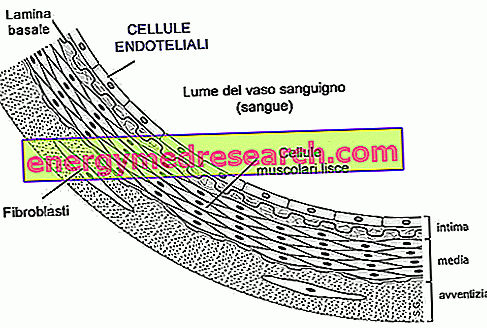Generality
Housed at the base of the neck, just below the Adam's apple, the thyroid is made up of two right and left glandular lobes, connected to each other by a thin isthmus placed between the second and fourth tracheal ring. In the adult the thyroid lobes measure about 4 cm in length, with a thickness and a width normally variable between 1.5 and 2 cm. The total weight of the gland is about 20 grams.

Causes
Any increase in thyroid volume, regardless of its nature, is termed "thyroid goiter". There are numerous and numerous possible causes responsible for the volumetric increase in the thyroid. The gland can grow slightly even under physiological conditions; thyroid hypertrophy is common during pregnancy (+ 13%), while it slightly increases in the first half of the menstrual cycle. Other times, the enlarged thyroid is a characteristic sign of particular diseases:
- Iodine deficiency: this mineral is essential for the correct synthesis of thyroid hormones; abundant in sea fish and algae, it is present in traces also in vegetables and meat in proportion to the iodine content of the soil. There are underdeveloped areas of the planet, located in the hinterland or in the highlands, where iodine deficiency is still a serious and particularly widespread problem, which can also be aggravated by the consumption of gozzigenium foods, such as broccoli and cauliflower. The enlargement of the thyroid is due to the stimulatory effect of TSH secreted by the pituitary gland, which - capturing the lack of thyroid hormones - releases this hormone in an attempt to increase the endocrine activity of the gland. Thyroid deficiency due to iodine deficiency is often referred to as "endemic goiter" or "simple goiter".
- Graves' disease: it is a common cause of hyperthyroidism, a condition caused by the excessive synthesis of thyroid hormones. In people suffering from Graves' disease, abnormal antibodies can be isolated which, by binding to TSH receptors, mimic their action, increasing the endocrine activity of the gland and with it its volume. The enlargement of the thyroid depends precisely on this stimulatory effect exerted by the abnormal antibodies.
- Hashimoto's disease: autoimmune disease associated with hypothyroidism, a condition caused by insufficient synthesis of thyroid hormones. In this case the abnormal antibodies reduce the endocrine capacity of the gland; similar to iodine deficiency, thyroid enlargement related to Hashimoto's thyroiditis is due to the compensatory effect of TSH.
- Multinodular goiter: the nodules of the thyroid are small clusters of roundish cells, sometimes well evident on palpation, which form at the base of the neck. Most often they are benign tumors (adenomas or cysts) that are completely asymptomatic, but in some circumstances they may be responsible for hyperthyroidism, or even more rarely evolve into a malignant tumor.
- Solitary nodule: compared to the previous case, the thyroid appears swollen due to the presence of a single large nodule. In general, the greater the nodule and the faster its growth, the greater the risk of malignant evolution.
- Thyroiditis: these are inflammatory processes of the thyroid, which increases in volume due to the local accumulation of liquids
- Thyroid cancer: far rarer than thyroid nodules, it generally appears as an abnormal enlargement of one side of the thyroid. In this case the nodular mass is particularly hard and also the satellite lymph nodes increase in volume and consistency.
Symptoms and consequences
In addition to thyroid ultrasound, which studies the gland from a morphological point of view by assessing its volume and the presence of any nodules, blood tests are very useful for investigating the health status of the gland, thanks to the possibility of measuring the plasma concentrations of the gland. TSH, thyroid hormones and abnormal antibodies that characterize certain thyroid diseases. More laborious investigations include thyroid scintigraphy with radioactive iodine and biopsy of the gland (needle aspiration).
The first, useful, indications to investigate the nature of abnormal thyroid enlargement derive from the simple observation of the symptoms reported by the patient. Not always, however, these are obvious: in some cases, in fact, the enlargement of the thyroid is absolutely benign since it does not involve significant alterations of its metabolism; consequently the plasma levels of thyroid hormones appear normal and the patient does not complain of any disorder; in this case we speak of euthyroid or euometabolic goitre, to differentiate it from the toxic or hyperthyroid (linked to hyperthyroidism) and from the hypothyroid one (linked to hypothyroidism).
Treatment
Treatment of thyroid goiter depends on the origin and extent of the disorder and the symptoms related to it. When the volume increase of the thyroid is contained, the doctor may decide to periodically monitor the situation without prescribing any specific drug or treatment. For the treatment of enlarged thyroid associated with hypothyroidism, synthetic analogues of thyroid hormones, such as levothyroxine, are prescribed (see the article on drugs for the treatment of hypothyroidism). In the opposite situation, the so-called thyrostatic drugs Methimazole or Tiamazole (eg Tapazole) are prescribed, associated with other active ingredients to control the symptoms of the disease (for example beta-blockers to counteract arrhythmias and palpitations: see the dedicated article: drugs for the treatment of hyperthyroidism). In case of hyperthyroidism it is also possible to undertake ablative therapy with iodine 131, which destroys the thyroid cells by reducing the volume of the goiter. If the enlarged thyroid causes disorders such as difficulty in breathing and swallowing, or the doctor deems it necessary due to the presence of suspicious nodules or a thyroid neoplasm, surgical removal of the gland can be performed.



